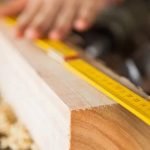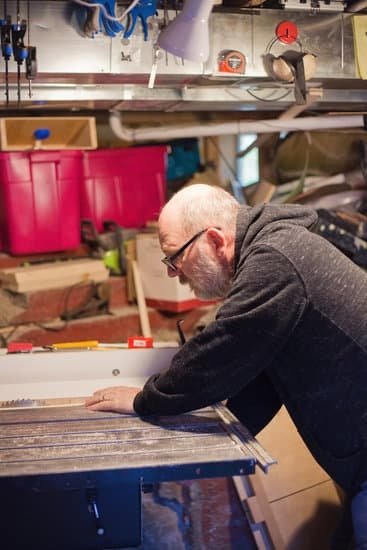Are you a woodworker looking to ensure that your material is ready for use? Learn how to tell if wood is dry enough for woodworking and avoid common mistakes that could compromise the quality of your projects.
When it comes to woodworking, using properly dried wood is crucial for the success of your projects. Whether you are crafting furniture, building cabinets, or creating decorative items, understanding the moisture content of the wood you are working with is essential in achieving high-quality craftsmanship.
Different types of wood have varying drying times, and it’s important to be able to identify these variations in order to properly prepare your materials. This article will guide you through the process of assessing wood dryness and provide you with practical tips for ensuring that your wood is ready for use in your woodworking endeavors.
Identifying the Different Types of Wood and Their Drying Times
One of the crucial aspects of woodworking is ensuring that the wood being used is adequately dried. The drying time for different types of wood varies, and understanding these differences is essential for producing high-quality woodworking projects. Each type of wood has its own unique characteristics, which can affect how long it takes for the wood to dry properly.
For example, softwoods like pine and cedar generally dry faster than hardwoods such as oak and maple. The density of the wood also plays a significant role in determining drying time, with denser woods taking longer to dry. Additionally, the environmental conditions in which the wood is being dried can impact the overall drying time.
Understanding the specific drying times for different types of wood is critical in ensuring that they are properly seasoned before being used in woodworking projects. Using wet or improperly dried wood can lead to warping, cracking, and other issues that can compromise the quality and integrity of woodworking pieces.
| Wood Type | Average Drying Time |
|---|---|
| Softwood (pine, cedar) | 6-12 months |
| Hardwood (oak, maple) | 1-2 years |
Properly identifying the type of wood being used and understanding its specific drying time is essential for any woodworking project. It allows woodworkers to plan ahead and ensure that they have adequately dried wood available for their crafting needs.
In summary, knowing how to identify different types of wood and their respective drying times is crucial for any woodworker. It allows for better planning and preparation, ultimately leading to higher quality woodworking projects. Understanding these factors will help prevent potential issues caused by using improperly dried wood in woodworking endeavors.
Methods for Checking the Moisture Content of Wood
Woodworking requires properly dried wood to ensure the quality and durability of the finished product. The moisture content of wood is a crucial factor in woodworking, as using wood with high moisture content can result in warping, cracking, and other defects in the final project. In this section, we will discuss various methods for checking the moisture content of wood to ensure that it is dry enough for woodworking.
One method for checking the moisture content of wood is by using a moisture meter. A moisture meter is a handy tool that accurately measures the percentage of water in the wood. By inserting the pins or sensors of the moisture meter into the wood, you can obtain an instant reading of its moisture content. This method is quick, easy, and provides precise results, making it a popular choice among woodworkers.
Another way to determine if wood is dry enough for woodworking is through visual and touch tests. Dry wood tends to be lighter in weight compared to wet or green wood. Additionally, dry wood usually has visible cracks on its ends and may produce a hollow sound when tapped. Using a combination of visual inspection and touch tests can provide a good indication of whether the wood has reached an acceptable level of dryness for woodworking.
Furthermore, weighing the wood before and after drying it in a kiln or oven can also provide an accurate measurement of its moisture content. By comparing the weight loss percentage, you can calculate the level of dryness achieved by the wood. This method may require more time and equipment but can be effective in determining if the wood is ready for use in woodworking projects.
| Method | Description |
|---|---|
| Moisture Meter | A tool that measures the percentage of water in wood by inserting pins or sensors into it. |
| Visual and Touch Tests | Determining dryness by observing visual cues such as cracks on ends and performing touch tests such as feeling its weight and hearing its sound. |
| Weighing Before and After Drying | Weighing wood before and after drying to compare weight loss percentages as an indicator of dryness. |
Using a Moisture Meter for Accurate Wood Moisture Readings
Understanding the Role of Moisture Meters in Woodworking
Moisture meters are essential tools for woodworkers to accurately determine the moisture content of wood. These handheld devices measure the percentage of water in the wood, allowing woodworkers to assess whether the wood is dry enough for woodworking projects.
Moisture meters come in two types: pin-type and pinless. Pin-type meters use two metal pins that penetrate the surface of the wood, while pinless meters work by using electromagnetic signals to measure the moisture content without leaving any marks on the wood.
How to Use a Moisture Meter
When using a moisture meter, it is important to follow the manufacturer’s instructions for accurate readings. To measure the moisture content, insert the pins of a pin-type meter or place the sensor of a pinless meter on different spots of the wood. Make sure to take readings from various locations as moisture levels can vary within a single piece of wood. Then, record and compare the measurements to determine if the wood is adequately dry for woodworking.
The Benefits of Using a Moisture Meter
By utilizing a moisture meter, woodworkers can make informed decisions about when to begin their woodworking projects and how to properly store their wood materials. This tool helps prevent issues such as warping, cracking, and structural instability that can arise from working with improperly dried wood.
Additionally, moisture meters can also aid in identifying if additional drying time is needed before proceeding with woodworking tasks. Incorporating this tool into one’s woodworking practice can contribute to better outcomes and ensure high-quality craftsmanship in woodworking projects.
Thus, knowing how to tell if wood is dry enough for woodworking involves using a moisture meter as an essential tool for achieving accurate and reliable measurements of wood moisture content.
Visual and Touch Tests for Determining Wood Dryness
When it comes to woodworking, using dry wood is crucial for the success of any project. The moisture content of the wood affects its workability, stability, and overall quality. In this section, we will explore the visual and touch tests that can be used to determine if wood is dry enough for woodworking.
One method for visually assessing the dryness of wood is to look for cracks or splits on the surface. As wood dries, it may develop small cracks, known as checking, which can be a sign that the wood has reached an appropriate level of dryness. Additionally, visually inspecting the color and texture of the wood can provide clues about its moisture content. Dry wood tends to have a lighter color and a smoother texture compared to wet or green wood.
Another way to gauge the dryness of wood is through touch. Dry wood will generally feel lighter in weight compared to wet wood. It may also produce a hollow sound when tapped, indicating that it has low moisture content. Additionally, dry wood tends to have a warmer temperature compared to wet wood.
To help you better understand how to tell if wood is dry enough for woodworking using visual and touch tests, here are some key indicators:
- Look for cracks or splits on the surface
- Inspect the color and texture of the wood
- Compare the weight of the wood
- Tap the wood to listen for a hollow sound
- Feel the temperature of the wood
Using these visual and touch tests in combination with other methods for checking moisture content can help ensure that you are using properly dried wood in your woodworking projects.
Factors Affecting Wood Drying Time
When it comes to woodworking, the drying time of wood is a crucial factor that can affect the outcome of your projects. Several factors can impact how long it takes for wood to dry properly, and understanding these factors is essential for achieving the best results in your woodworking endeavors.
Wood Species
Different types of wood species have varying levels of moisture content, which can influence their drying time. Hardwoods tend to have a longer drying time compared to softwoods due to their denser nature. It’s important to research and understand the specific drying times for the type of wood you’re working with to ensure that it’s adequately dried before using it in your woodworking projects.
Air Circulation and Humidity
The environment in which the wood is stored plays a significant role in its drying time. Proper air circulation and controlled humidity levels are essential for facilitating the drying process. Wood that is exposed to well-ventilated areas with low humidity levels will dry more efficiently compared to wood stored in damp or poorly ventilated spaces.
Wood Thickness and Cut
The thickness of the wood and how it was cut also affects its drying time. Thicker pieces of wood will naturally take longer to dry compared to thinner pieces. Additionally, how the wood was cut, such as plain sawn or quarter sawn, can impact its moisture content and overall drying rate.
Understanding these factors and their effects on wood drying time is crucial for ensuring that the wood you use in your woodworking projects is adequately dried. By taking these factors into consideration, you can better assess when your wood is dry enough for woodworking, resulting in high-quality craftsmanship.
Precautions and Tips for Properly Drying Wood
Properly drying wood is essential for successful woodworking projects. Wet or green wood can lead to warping, splitting, and shrinking, affecting the quality and durability of your finished piece. Here are some precautions and tips for ensuring that your wood is properly dried before starting any woodworking project:
Precautions:
1. Avoid using green or freshly cut wood: Green wood contains a high moisture content that can result in cracking and distortion as it dries. It’s best to let the wood dry out naturally or use a kiln to speed up the process.
2. Protect wood from direct sunlight and extreme temperatures: Exposure to direct sunlight or extreme temperature changes can cause the wood to dry too quickly, leading to cracks and deformations.
3. Store wood in a well-ventilated area: Proper air circulation is crucial for ensuring that the wood dries evenly and consistently.
Tips:
– Use a moisture meter to check the moisture content of the wood: A moisture meter is an essential tool for accurately determining the moisture content of wood before using it for your woodworking projects.
– Allow for acclimation time: Once the wood has reached its desired moisture content, allow it to acclimate to the environment where it will be used for at least 48 hours before beginning any woodworking tasks.
– Keep track of drying time: Different types of woods have different drying times, so it’s important to keep track of how long each type has been drying. This will help you determine when it’s ready for use in your projects.
By taking these precautions and following these tips, you can ensure that your wood is properly dried and ready for use in your woodworking projects.
Common Mistakes to Avoid When Assessing Wood Dryness for Woodworking
One common mistake to avoid when assessing wood dryness for woodworking is relying solely on visual inspection. While the appearance of wood can give some indication of its moisture content, it is not always a reliable method. Wood that appears dry on the surface may still have high moisture content inside, leading to warping, cracking, or other issues in the finished project.
Another mistake is assuming all types of wood dry at the same rate. Different species of wood have different drying times, and failure to account for this can result in using improperly dried wood in a project. It’s important to research and understand the specific drying times for the type of wood you are working with in order to ensure its suitability for your woodworking project.
Additionally, one should avoid solely relying on touch tests to determine if wood is dry enough for woodworking. While feeling the moisture content of wood with your hands can provide some information, it is not a precise method and can lead to inaccuracies. To ensure accuracy when assessing wood dryness, it’s essential to use a combination of methods such as moisture meters, weight measurements, and specialized testing equipment.
By avoiding these common mistakes when assessing wood dryness for woodworking projects, craftspeople can ensure that they are using properly dried wood that will result in high-quality finished products. Understanding the various factors that affect wood drying time and utilizing accurate assessment methods will lead to better outcomes in woodworking craftsmanship.
Practical Applications
Woodworking projects require the use of dry wood to ensure a successful and high-quality outcome. Whether you are building furniture, crafting decorative items, or constructing wooden structures, using properly dried wood is essential for the durability and stability of your woodworking projects. In this section, we will discuss practical applications for using dry wood in woodworking projects, as well as the benefits of doing so.
One practical application of using dry wood in woodworking projects is to prevent warping, cracking, and structural instability. When wood contains high moisture content, it is more prone to changes in shape and size as it dries further. This can lead to misaligned joints, uneven surfaces, and overall poor craftsmanship. By using properly dried wood, you can ensure that your woodworking projects maintain their shape and structural integrity over time.
In addition to preventing costly mistakes and ensuring the quality of your woodworking projects, using dry wood also allows for easier workability and finishing. Dry wood is typically easier to cut, shape, and sand compared to wet or green wood. It also absorbs stains, paints, and finishes more evenly, resulting in a smoother and more professional-looking final product.
Therefore, utilizing dry wood in woodworking not only improves the overall quality but also enhances the aesthetic appeal of your creations. Understanding how to tell if wood is dry enough for woodworking is crucial for achieving these practical benefits in your projects.
By Incorporating the Use of Properly Dried Wood Into Your Woodworking Projects,
you can take advantage of its stability and workability while avoiding common pitfalls associated with working with wet or improperly dried lumber.
Ensure that you accurately assess the moisture content of the wood before starting any project by employing reliable testing methods such as moisture meters or visual and touch tests. Keep in mind that different types of woods have varying drying times due to their density and porosity characteristics. By understanding these factors.
And Following Proper Drying Techniques,
you can maximize the benefits of using dry wood in your woodworking endeavors.
Conclusion
In conclusion, it is crucial to ensure that wood is thoroughly dry before using it for woodworking projects. The moisture content of the wood plays a significant role in the quality and durability of the finished products. As discussed in this article, understanding the importance of dry wood in woodworking, identifying different types of wood and their drying times, and using accurate methods for checking the moisture content are all essential steps in ensuring the quality of woodworking craftsmanship.
By utilizing a moisture meter, woodworkers can obtain precise measurements of the moisture content in wood, allowing them to make informed decisions about its suitability for use. Additionally, visual and touch tests can provide valuable indications of dryness, but they should be complemented by more reliable methods such as a moisture meter to ensure accuracy.
Frequently Asked Questions
How Dry Does Wood Need to Be for Woodworking?
The ideal moisture content for woodworking is generally around 6-8%. This ensures that the wood is stable and won’t warp or shrink after being fashioned into a piece of furniture or other item.
How Do You Test Wood Dryness?
One common way to test wood dryness is by using a moisture meter, which can accurately measure the percentage of moisture in the wood. Another method is by weighing the wood before and after drying it in an oven to calculate its moisture content.
How Do You Know if Wood Is Good for Woodworking?
To determine if wood is good for woodworking, you should inspect it for any cracks, knots, or signs of decay. Additionally, consider the type of wood and its intended use – certain woods are better suited for different projects based on their hardness, texture, and grain pattern.

Hi everyone! I’m a woodworker and blogger, and this is my woodworking blog. In my blog, I share tips and tricks for woodworkers of all skill levels, as well as project ideas that you can try yourself.





